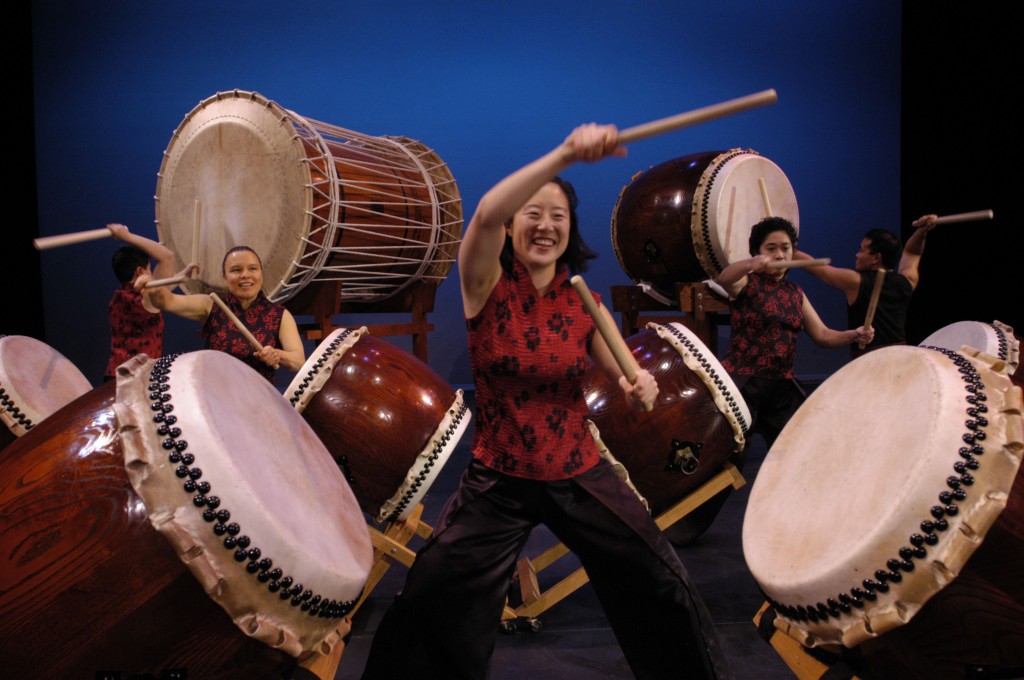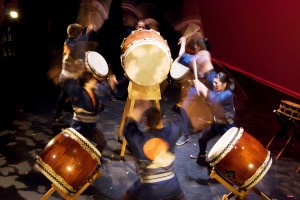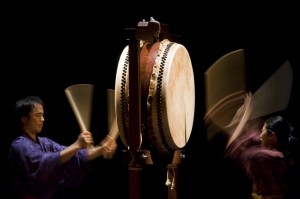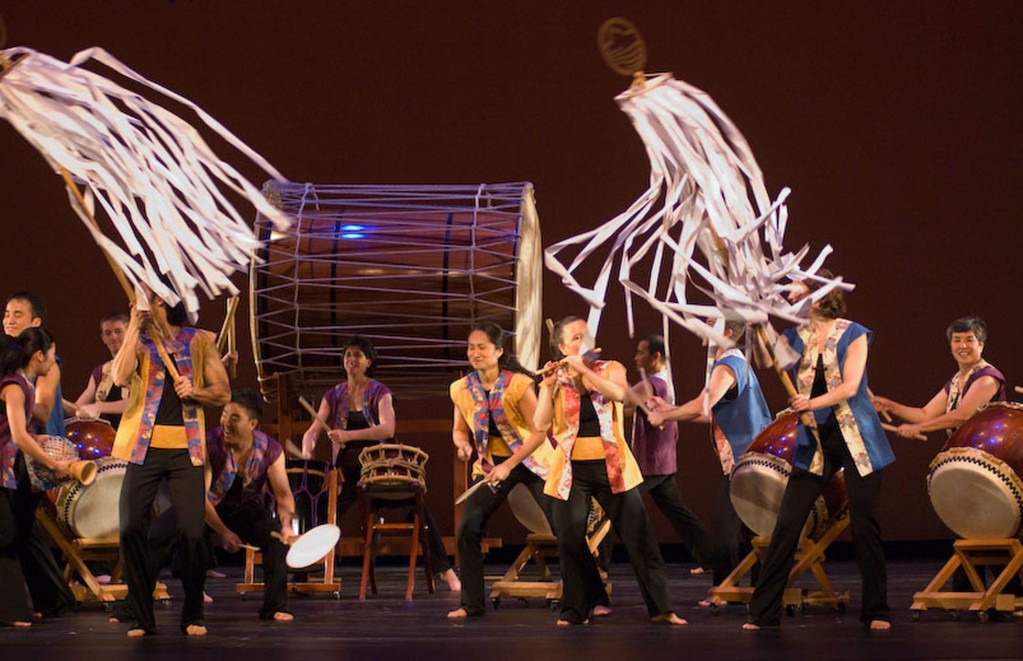
People talk about how making a movie is mostly about standing around and waiting. But all performance arts have those quiet times — the quiets before the storms — and before a recording session it’s a busy quiet. You’re not just getting yourself ready, the way you routinely do before any performance. You’re making sure the instruments and recording apparati are just right, too.
One night not too long ago I drove out to the theater at Clackamas Community College near Oregon City, where the drumming ensemble Portland Taiko was in the last stages of recording its newest CD, and it made for one of the more intriguing hurry-up-and-waits I’ve sat through in quite a while. I was invited not as a working journalist but as a friend of the company: I’ve recently joined Portland Taiko’s board, marking the first time, after decades of observing arts organizations, that I’ve taken a hand at actually making decisions to help one do its work.
Recording sessions are funny things, and this one, for the CD Rhythms of Change: The Way Home, which will be released in August, is no exception. In order to get those precious moments of surging, melting sound, everything has to be prepared just so. Which generally means laying down an undergrowth of electrical wires, erecting a small forest of microphone booms, placing and re-placing baffles and makeshift mufflers (an old blanket might do the trick), arranging and rearranging the positions of players and instruments so that sometimes the people playing can neither see nor hear one another. The focus is up there, above the seats, behind those glass doors in the booth. That’s where everything has to balance and play right.
On this night the ensemble is getting ready to record a piece called Slipping Through My Fingers, by artistic director Michelle Fujii, that features not only the array of drums that are central to taiko but also a violin, which alternately leads and counterbalances the sound. Except that most of the drummers can’t actually see the violinist, Keiko Araki, who is standing far stage left, hidden from view by a mini-wall of sound-directing barriers.
The drums range from a little bigger than trap size to the looming odaiko, a fatter-than-a-bass drum sitting on a gorgeous wooden stand. All of these hand-fashioned drums are beautiful, from their stretched skins to their burnished wooden finishes to their finely polished metal stays and tuners. But on this night, beauty — that is, visual beauty, which is of no consequence to a sound recording — doesn’t count. Most of the drums are wrapped inelegantly in white T-shirts to keep any metal parts from rattling. (You’d also better not cough, and your shoes had better not be squeaky.)
Music might be quicksilver, but it’s also mechanical, and this time before the recording begins is very much tech time. Four players squat around a single thigh-high drum, adjusting it as a fifth musician gives it a series of tuning thwocks. Tweaks must be made, and the tuning key isn’t cooperating.
 One player looks up.
One player looks up.
“Do we have a hammer?”
“We must have, yeah.”
“It’s hammer time!”
And another player heads offstage to fetch it.
Mark Frethem, the veteran sound engineer who’s in charge of the recording session, seems happy with the site and the way things are coming together. Later, from the booth, he’ll call for adjustments — “Swap 16 for 23, and 17 for 24,” he says at one point about the electrical connections, and one of the techies quickly unplugs and replugs the lines so the mix will sound better upstairs — but 20 minutes before recording begins, the shape of things is pretty well set. Frethem worries a little about dead zones inside the theater, but overall he thinks it’s a good space for recording. He’s recorded marimba groups in the college’s nearby band room, he says, but that space has too bright a sound for taiko.
Brightness, and darkness, and resonance are critical. Because the drums must carry not just the rhythm but also most of the melodics and harmonics, tone and tune are vital. There are cymbals and rattles and gongs and flutes as well — sometimes a taiko group can bear a passing resemblance to an Indonesian gamelan orchestra, at least in its variety of contributing sounds — and often, at Portland Taiko, there are Western instruments from the string family. But this is essentially a music of the drums.
Like butoh, the exquisite form of slow-motion Japanese dancing, modern taiko developed in the years after World War II, partly as a way to keep Japanese tradition (the taiko drum has held a ceremonial role for centuries) and partly as a way to break from the past. It is at once a form of remembrance and a statement that this is a new world. In the United States, where taiko got a toehold in the 1960s, it’s adopted a particularly American approach, borrowing from other musical forms and drawing inspiration musically from jazz and culturally from the black civil rights movement. From the beginning Portland Taiko has been pan-Asian (company mainstay and producing director Teresa Enrico, for instance, is Philippine American) and has always had some European American members.
A sense of liberation underlies the taiko evolution, both culturally and personally. It’s pretty hard to bang one of these drums and not feel a sense of release, and power, and elation. Perhaps because of this, taiko appeals to a lot of women. The group assembled to record Slipping Through My Fingers includes, if my counting’s right, 17 musicians. Thirteen are women. And they can shout.
You know the phrase, “Close enough for jazz”? It’s not true for jazz, and it’s not true for taiko, an art form that begins with a simple pulse, or ji, but which can become as complex and musically sophisticated as its players and composers make it. Precision drives all of that exuberance of sound. And precision is no accident.
The musicians settle into place by their instruments, and it’s warmup time. Fujii, the artistic director and also the composer of this piece, leads a series of vocal exercises.
“Ka! Ka! Ko! Don-don. Ka! Ka! Don-don-don-don,” the players chant.
It’s the sound of the drums, vocalized: the sharp “ka!” the sound of striking the rim, the round “don” the full sound of striking the head.
 Taiko is a visual as well as a musical form, and dance — the choreography of moving among and around the drums, of how the strikes are made and how the players interact — is vital, especially in Fujii’s interpretation of the art. In a recording session, all of those visual aspects of the performance are shut down, and that can be inhibiting, because normally, in front of a crowd, it all works together, the movement loosening the atmosphere so the music can flow.
Taiko is a visual as well as a musical form, and dance — the choreography of moving among and around the drums, of how the strikes are made and how the players interact — is vital, especially in Fujii’s interpretation of the art. In a recording session, all of those visual aspects of the performance are shut down, and that can be inhibiting, because normally, in front of a crowd, it all works together, the movement loosening the atmosphere so the music can flow.
And for the recording, the sound is going to have to be loose: It can’t feel rigid.
Before the first take Fujii, at the front of the stage, talks about tempo — when she’ll be accelerating, when she’ll be pulling back. She’s explaining the music part of the equation: the melting, the flow, the expression beyond the mere rhythm and notes. In warmups it’s been hard for the musicians to hear one another. The drummers are following the violinist, but they can’t hear her. They’re looking for compensating visual cues, and they’re a flick late. So Fujii asks Byron Au Yong, a Seattle-based composer who works internationally and has collaborated with several taiko groups, to stand out in the auditorium where everyone can see him. From a few rows up, he patiently motions entrances and keeps the beat: It’s all in the timing. (Earlier, Au Yong has approached the few visitors with a box full of ear plugs. “You might want to wear these,” he says, smiling. “Taiko can be pretty loud.” But I notice that everyone just seems to let them dangle around their necks.)
Take 1 begins and finishes, a building storm with eyes of quiet and contemplation.
At the end, there are several seconds of waiting, while the recording equipment is still running, and the room holds its breath. Then an exhalation, and some giggles of relief.
Fujii sits a moment, thinking, then looks up at the booth.
“Can I listen to that take?” she asks.
“Absolutely,” Frethem replies. “Come on up.”
She listens, and returns.
It’s sounded a little stiff, a little rote. The problem is to keep up the energy and the tempo even when the volume goes down. Otherwise, the sound can sag and drag. The musicians need to get in front of the beat, not behind the beat, she tells them: “revving up, revving up, revving up.”
What Fujii talks about now is less the technique of the performance than the feel of the piece, the intangible qualities that take it out of the realm of the metronome and give it vibrancy and shape.
“It sounds like you’re visualizing a beach,” she tells the group. She wants something different — something mysterious and urgent, “like you’re walking down a hallway and you see a door but you don’t know what’s behind the door. You need to push forward.”
Take 2 begins, and the musicians push. The sound melts: It finds that exciting balance between structure and unpredictability. Fujii goes to the booth again, and comes back smiling.
“That one sounded good,” she says. “Let’s do one more.”
The musicians, expectant, get in place. Au Yong stands in the auditorium, arms extended, ready for the opening downbeat.
“Slipping, Take 3,” he says firmly.
Roll of thunder, hear my cry.

Photos: Copyright Rich Iwasaki